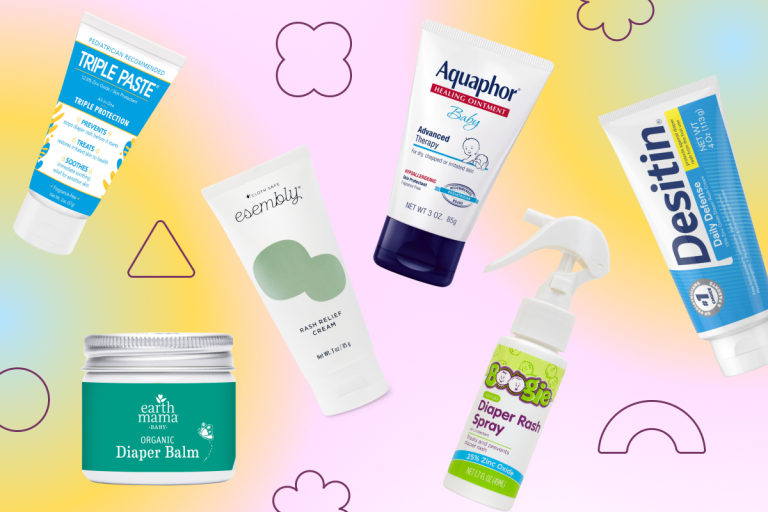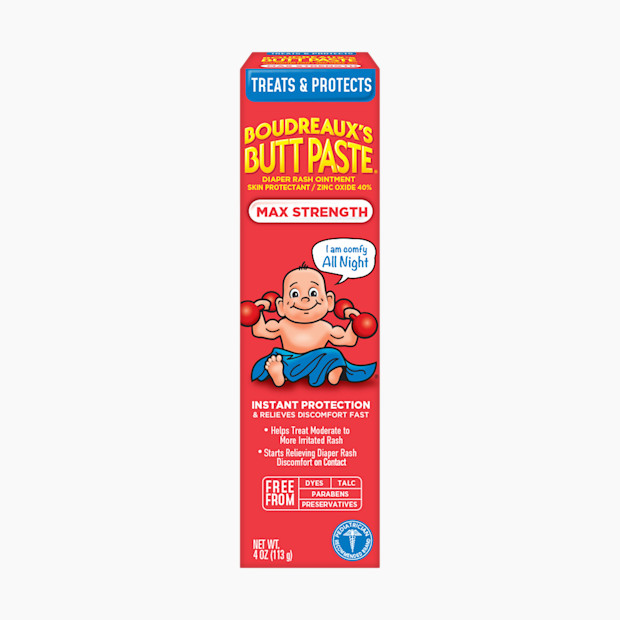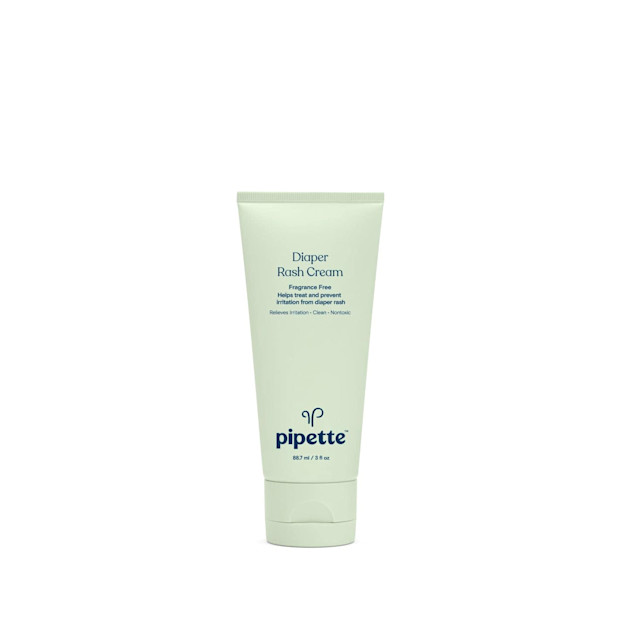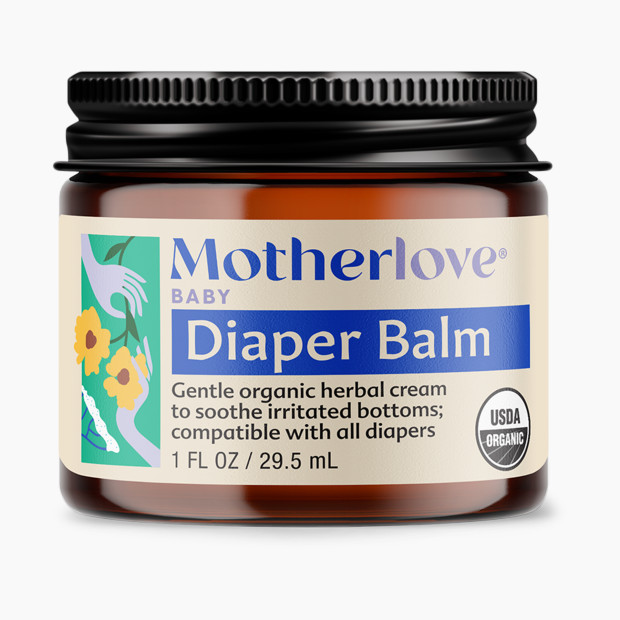
The Best Diaper Rash Creams for Happy Baby Bottoms
Diaper rash = one unhappy baby. Here are our tip picks to soothe and protect their sensitive skin.

By Briana Engelbrecht
Medically Reviewed by Brittany DiBardino DO
Fact Checked by Shannon Vestal Robson
In This Article
Diaper rash can happen whether you’re using disposable diapers or going the cloth route, and while it’s no picnic for babies, it turns out it’s pretty common. Dr. Christina Johns, a board certified pediatrician who primarily works in the urgent care space says, “You would be amazed at the number of parents who bring their child in for diaper issues.” It can be hard to see your little one uncomfortable, but the good news is that the right cream (and a few best practices we’ll dive into below) can soothe irritation and treat the rash by providing a protective barrier on baby's delicate skin. They can also help prevent rashes from developing in the first place. A good diaper cream is something you’ll definitely want to include in your designated changing station and in your diaper bag.
There are a lot of different creams, pastes and ointments on the market, and it can be tricky for new parents to figure out what’ll work best for their baby, so we've rounded up the best diaper rash creams to help you choose. Desitin Daily Defense is our best overall pick thanks to its thick consistency, effectiveness and affordable price. But as with most things in the world of baby products, there isn’t one best pick for every baby—so we have a handful of other options to help you find the one. (And a pro tip: diaper cream is one of a few baby products that are HSA/FSA eligible!)
- Best PreventativeAquaphor Baby Healing Ointment Advanced Therapy Skin ProtectantFrom $12.99
Why Trust Babylist?
Babylist is the expert in baby; we know baby gear inside and out. We talk with parents face-to-face in our showroom and on our user panels and hear from thousands annually via our Best Baby Products online survey. We know what items millions of expecting parents are adding to their baby registries.
Firsthand professional and personal experience. In addition to being Babylist’s assistant editor, I’m also a mom of two children, one of whom had very sensitive skin as a newborn. I used insight from both of these areas of life when writing this guide. Jen LaBracio, Babylist’s senior gear editor, is the original author of this piece; I also leaned into her original research and insight.
Expert POV. For an expert POV, I spoke to Dr. Christina Johns, a board certified emergency physician and Senior Medical Advisor at PM Pediatric Care.
Diaper rash cream data. As an editor at Babylist, I regularly analyze which baby products our users are adding to their baby registries the most (and which ones they aren’t) and what our team of Merchandising experts—our buyers who are responsible for ensuring the Babylist Shop is stocked with the best and newest gear—is excited about. Studying this kind of data helped us choose which diaper creams to test and which ones to recommend to new and expecting parents.
Feedback and reviews. I reviewed comments and feedback from Babylist’s annual product survey of thousands of Babylist parents, read customer reviews from hundreds of Babylist users and spoke to parents on our Babylist staff about their real-life diaper cream experiences.
How We Judged the Best Diaper Creams
Best Diaper Cream Overall
Pros
- Thick, paste-like consistency
- Affordable
- Parent favorite
Cons
- Tricky to wipe off
- Light smell
Desitin’s Daily Defense cream, from a well-known brand trusted for generations, has earned its spot as many parents' secret weapon for treating diaper rash, which is why it’s our best overall pick. With a 13% zinc oxide formula, this cream creates an effective barrier against moisture to protect irritated skin so it can heal, and works to prevent rash from appearing at all. “I generally trend towards very thick ointments as opposed to thinner creams,” says Dr. Johns, citing that they provide a thick layer and stay put. Desitin is incredibly effective, often showing improvement within just a few diaper changes, and a little goes a long way.
That same thick texture can make this cream tricky to apply and wash off. It also has a faint medicinal smell, and some parents note it can stain clothes.
Best for Severe Diaper Rash
Triple Paste Diaper Rash Ointment - 2 Oz
From $8.92Pros
- Thick protective barrier
- Parents say it works quickly
Cons
- Hard to clean off
- Pricey
It was tough to choose a best overall diaper cream for this guide since it really depends on your baby’s specific needs. Triple Paste is our pick for treating severe rashes because it provides the same soothing, thick protective barrier as Desitin but has a little extra “oomph” when it comes to how quickly it works. Any parent who's faced a raging case of diaper rash (and a very unhappy baby) wants one thing: instant relief. Thanks to the fast-acting formula (which was developed based on prescription diaper creams), Triple Paste is a saving grace for sore bottoms. The zinc-based, extra-thick cream is fragrance-free, hypoallergenic and stays put so irritated skin can heal.
Parents’ biggest gripe with Triple Paste is that it’s hard to clean off of your fingers and baby’s bum if you wanted to. But the benefits outweigh that issue, and you typically don’t need to remove the paste completely during each change. (By the way, the brand also offers a bundle that comes with a jar of Triple Paste and an application tool). It’s also a bit expensive compared to other options.
Best Organic Diaper Rash Cream
Pros
- Organic ingredients
- Multi-purpose skin salve
- A little goes a long way
Cons
- Pricey
- Thinner consistency
Many new parents are nervous about the products they use on their babies’ skin. If you’re looking for an organic diaper cream, Earth Mama is a great option. Although it's called a balm, this herbal remedy helps heal all sorts of ailments, including rashes, burns, cuts, scrapes and bug bites. It’s made with organic oils, herbal extracts and botanicals, and has a thinner, non-sticky consistency. It’s completely zinc, petroleum and fragrance free and certified organic by the USDA. Although it's a small container, a little goes a long way in relieving and warding off diaper rash.
One thing some parents note in their reviews is that it’s not as effective on a full-blown diaper rash, saying it’s better as an everyday, preventative layer. The balm also doesn’t provide as thick of a barrier as a diaper cream with zinc would, which is sometimes all irritated skin needs to heal. One Babylist parent wrote in their review, “When our newborn developed a bad diaper rash (think raw, broken skin), I found this product seemed to help soothe the area, but I had to use a diaper paste over top of it to provide [more of] a moisture barrier. [This] just rubs off.” Like most baby products, you might need to try a few to find what works best for your baby’s skin. If their rash doesn’t go away in a few days or after applying treatment, be sure to reach out to your pediatrician.
Best Preventative Diaper Rash Cream
Aquaphor Baby Healing Ointment Advanced Therapy Skin Protectant
From $12.99Pros
- Multi-use ointment
- Unscented
Cons
- Can stain clothes
Sometimes the best way to prevent diaper rash is to treat it before it ever starts—and this petroleum-based ointment from parent-favorite Aquaphor does the trick right from day one. It’s easy to apply (think vaseline consistency) and offers a thin barrier to keep urine and stool away from baby’s skin. And the best part is, it’s multi-purpose. One Babylist parent wrote in our best baby products survey, “Can’t express how helpful it is. [It] cures all scratches, cuts, rashes and dry skin.” Many parents mention using it for other baby skin needs like chapped cheeks and drool rash or minor scrapes (it’s also good for adults, too! I still use it as a lip balm). If you want a bigger size, it’s also available in a jar (though parents say it’s not convenient for on-the-go and can get messy).
One thing to note: Aquaphor’s “baby” ointment and regular ointment are essentially the same and you can use either for a preventative barrier. They do offer a 3-in-1 Diaper Rash Relief Cream that contains 14 percent zinc oxide if you want to try something a bit thicker, but not as thick as say, Desitin or Triple Paste.
I’ve used this with both of my kids and found it was worth it to have in our stash just in case. A few parents mention it doesn’t work well on severe irritation, and they find using this in combination with a thicker paste-like cream, like Desitin, works better for moderate to severe diaper rashes. You’ll also want to be careful not to get it on clothing, as it can be tricky to wash out and sometimes leaves a greasy stain.
Best Affordable Diaper Rash Cream
Pros
- Budget-friendly
- Parents say it’s similar to Desitin
- Talc-free
Cons
- Only available at Walmart
- Hard to wipe off of fingers
Parent’s Choice, a brand exclusive to Walmart, is well-loved by parents for its affordable prices and good quality products. This diaper rash ointment is no exception—and costs just two dollars a tube. It’s got many of the same ingredients as other name brands on this list but at a fraction of the cost, it's a great budget-friendly option.
With 40 percent zinc oxide as the main ingredient, it’s got a thick paste-like consistency that acts as a barrier to protect baby’s bum and quite a few parent reviews mention that it's similar to Desitin. It’s also talc-free, which isn’t the case for most store brand diaper creams.
While it’s great for clearing diaper rashes, parents mention it’s hard to clean off of their fingers after applying. Just note, since it’s a Walmart store brand, you can only buy it there.
Best Sprayable Diaper Rash Cream
Boogie No-Rub Diaper Rash Spray - Green, 1.7 Oz
From $9.97Pros
- No-touch, mess-free application
- Sprays evenly
- Nice consistency
Cons
- Small container
- Sprayer gets clogged
A sprayable diaper cream may sound a bit strange, but hear us out. Babylist parents rave about how convenient this sprayable diaper rash cream from Boogie is; in fact, quite a few called it out in our best baby products survey. The spray mechanism means avoiding thick diaper cream under your nails or on your fingers. It’s also a gentle no-contact way to apply diaper cream to irritated skin. “It seems silly but this has been a lifesaver!” one Babylist parent wrote. And best of all, it actually works. Parents notice it’s effective at protecting, soothing and healing irritated bums.
There are a few things parents don’t love, though. Their biggest gripe is the spray mechanism—many find that it either breaks or gets clogged rather easily. It’s also a pretty small tube, which is great for throwing it in your diaper bag or caddy, but many wish Boogie offered a refill bottle so they didn’t need to buy a new one each time.
Best for Cloth Diapers
Pros
- Easy to wash off
- A little goes a long way
Cons
- Only to treat (not prevent)
This zinc-based cream not only heals and soothes painful diaper rashes, it’s designed by cloth diaper brand Esembly, so you can bet they're well versed in the ins and outs of cloth diapers. While other rash creams and ointments might leave stains or be hard to wash off, this one thoroughly washes off of reusable diapers.
It’s a bit pricey, but Babylist parents agree that a little goes a long way. You only need a small amount, and Esembly recommends rubbing it in a bit like you would a lotion. One thing to note: unlike the other diaper creams on this list that double as prevention, this one should only be used for treatment (when a rash is present). For day-to-day skin protection that’s also cloth-diaper approved, check out the Esembly Everyday Balm.
Best Diaper Cream Sampler
Pros
- Convenient “try before you buy” kit
- Variety of options
Cons
- Some say it’s expensive for what it includes
- Smaller sizes
Choosing a diaper cream is a pretty personal decision; what works for one baby might not do anything for another, which is why we love this sampler box. The Diaper Cream Box comes with a few of the most popular diaper creams on the market (all of which you can find on this list) so you can figure out which formula and brand you prefer. Some Babylist parent reviews mention the kit is a bit pricey since you only get travel-sized products. Still, they note they appreciate the chance to try a few different options and say it’s perfect for adding to your registry.
Other Diaper Rash Creams We Recommend
Finding the right diaper cream can take a few tries and what works for one baby's skin might not produce the same results for another's. Here are a few more diaper creams to check out if none of the ones on this list are the right fit:

Boudreaux's Butt Paste
Maximum Strength Diaper Rash Cream
Types of Diaper Rashes
There are four types of diaper rashes you may encounter, and an irritant rash is what Dr. Johns says is most common. Here are the others to be aware of and we'll jump into how each type is treated below.
Irritant diaper rash. This is the most common type of diaper rash and is caused by your baby's skin being in prolonged contact with urine or stool. It looks like pink or red patches on your baby's skin where it's in contact with the diaper.
Yeast infection. This type of diaper rash is caused by a fungus found naturally in your baby's digestive tract. A yeast infection rash will often look like shiny, bright red or pink patches with sharp edges. There also may be pink bumps or even sores or cracking skin in some (rare) instances.
Bacterial. Also called impetigo, certain types of bacteria can also be a cause of diaper rash. (Staph and strep are two common ones.) Clues that your baby's diaper rash may be bacterial include bright red skin around the anus or yellow crusting, weeping or pimples.
Allergic. Sensitive skin is very common in babies. Things like fragrances or specific ingredients in diapers, wipes and creams may cause your baby's skin to react.
It can be tricky for parents to tell which type of diaper rash their baby is dealing with. Always reach out to your baby’s doctor if you have any concerns and especially if the rash doesn’t go away in a day or two after you apply diaper cream. Baby spiking a fever and or not feeding well are two more red flags Dr. Johns says to keep an eye out for.
How to Treat Diaper Rash
The best way to treat diaper rash is to try and prevent it before it happens, and apply a thick barrier as soon as you see any signs of irritation.
To treat an irritant diaper rash, there are a few steps you can take. First, change diapers often to avoid long contact with moisture.
Make sure your little one's bum is completely dry before putting on a new diaper. (Blowing lightly on the area or patting it with a dry cloth can help speed this along.)
Apply diaper cream at every diaper change to create a protective barrier that keeps moisture out.
Treat diaper rashes with cream at the first sign to soothe and calm red skin.
Go diaper-free for a really uncomfortable rash. (This can get messy, but sometimes a bare bottom is necessary and really does the trick.)
If your baby has a diaper rash that won't go away, a visit to the doctors is in order. Your baby's pediatrician will be able to determine whether you're dealing with a yeast or bacteria-related rash, both of which require a little extra help to clear them up. For a yeast infection diaper rash, they'll likely prescribe a type of topical anti-fungal cream to get rid of the yeast overgrowth. For bacterial-related rashes, you'll probably get a prescription of antibiotics for treatment (in the form of a cream or ointment).
If you suspect an allergy-related diaper rash, try switching brands of diapers, wipes and/or diaper cream to see if the rash improves. Sometimes it takes a few weeks for an allergic rash to fully heal, so be sure to stay the course and consult your baby’s pediatrician for support.
How to Prevent Diaper Rash
Sometimes the best thing you can do for diaper rash is try to prevent it before it ever happens. Dr. Johns shared a few tips for how parents can do this. “Number one, limiting the amount of substances, which include wipes and diapers, that your baby comes into contact with that [have] any kind of fragrances or alcohols is really important,” says Dr. Johns. Making sure you're doing frequent diaper changes to avoid prolonged contact with a soiled diaper is also important.
She also recommends giving babies a few minutes of diaper free time every day to sort of air things out. This can be as simple as waiting a few extra minutes before putting a diaper on after bath, or during the first change of the morning. (Pro tip: place a towel or disposable change pad underneath them just in case.) And lastly, making sure you’re not wiping baby's bum too hard can help avoid irritation.
Should you apply diaper cream at each and every diaper change? Maybe. “This is where the art and science of medicine and parenting and all that collide together because it's really individual. You kind of need to know your child and [their] skin,” Dr. Johns says. Some babies have super sensitive skin and will need something applied at each change, while others do fine with one or two applications a day. You also don’t need to completely wipe all of the cream off each change either, you can simply wipe and pat around it. This is especially helpful if you’re using those thicker zinc-based creams because it can take a bit of elbow grease to get it off, which can in turn irritate baby’s skin. In general, Dr. Johns recommends approaching your baby's diaper cream routine with the least amount of intervention first, and then going from there.
How to Choose a Diaper Rash Cream
First things first: Dr. Johns says she wants parents to think of diaper cream more as a paste than a cream, which tend to have more water in them and evoke lotion-like substance. You want rash prevention and treatment that'll provide a nice, thick barrier.
When you’re shopping for diaper rash cream, the two main ingredients to look for are zinc oxide and petroleum.
Diaper creams with zinc oxide as an active ingredient will be white in color and very thick (that paste consistency Dr. Johns mentioned). Zinc oxide is insoluble in water, which makes it a great barrier against moisture. Ointment-based creams are often made from petroleum jelly. They're also very thick and form an insoluble barrier between your baby's skin and their diaper, but are clearer in color.
Both types of diaper rash creams are very good at protecting your baby's sensitive skin. In fact, it's a good idea to have one of each in your stash. Petroleum-based creams (like Aquaphor) help to prevent diaper rash before it starts (or treat a more minor case), while zinc-oxide-based creams (like Desitin and Triple Paste) tend to be a bit better at treating and healing diaper rash.
Dr. Johns says diaper creams are one of those things you might have to go through a little trial and error to see what works best for your baby. “Look for those [with] the general consistency of a paste or [thick] ointment [and] make sure that there's no alcohols or fragrances,” which can exacerbate and even cause a rash. She also recommends looking for a cream with a high zinc oxide formulation because the higher the content of zinc, the thicker "paste" you'll get. She also recommends skipping those creams that contain talc because of potential health concerns, "Talc should be avoided in both creams and powders. I would skip any creams with talc," Dr. Johns says. (All of the picks on our list are talc-free).
Frequently Asked Questions
What does diaper rash look like?
While there are different types of diaper rashes, most diaper rashes will make your baby's skin look red, irritated, possibly bumpy and may make it feel warm to the touch. Diaper rash may appear on or between butt cheeks, on inner thighs and/or around the genital area.
What causes diaper rash?
No matter how absorbent your diapers are (and they’re pretty great at wicking away moisture these days) or how frequently you hit the changing table, baby bums are sensitive to moisture and the products you use on them. They can be caused by the diaper itself (either from chafing or fragrances, if there are any present) or by the acid that naturally occurs in urine and stool. Introducing new foods into your baby's diet or antibiotics can also trigger a rash.
Other causes of diaper rash include the overgrowth of a type of fungus found naturally in your baby's digestive tract, an allergy or, in rare cases, a bacterial infection. It’s hard to tell what type of rash your baby has just from looking at it, which is why Dr. Johns says she encourages parents to reach out to their pediatrician with any concerns.
How long does diaper rash last?
Most diaper rashes last two or three days if you're treating it at home by keeping the area clean and covering it with diaper rash cream. If it lasts longer than three days, try switching to a different diaper cream for a few more days and reach out to your baby’s doctor.
When should you call the pediatrician about diaper rash?
In some instances, your baby's diaper rash will last longer than a few days. You might need a prescription cream or other medication from your pediatrician. Here's how you'll know it's time to contact your child's doctor:
The rash isn't going away (or is getting worse) after about three days of treatment.
The rash includes pimples, peeling skin, blisters, pus-filled or oozing sores.
The rash is very painful.
Your baby develops a fever along with the diaper rash.
Your baby is on an antibiotic and you're seeing a bright pink or red rash with red spots along the edges.
Expert Sources
Babylist uses high-quality subject matter experts to provide accurate and reliable information to our users. Sources for this story include:
Christina Johns, MD, board certified pediatrician and Senior Medical Advisor at PM Pediatric Care.









